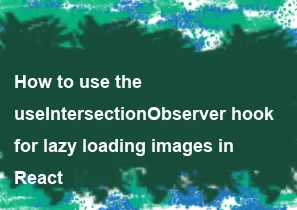How to use the useIntersectionObserver hook for lazy loading images in React

To use the useIntersectionObserver hook for lazy loading images in React, you can create a custom hook that observes when an image enters the viewport and loads it dynamically. Here's how you can implement it:
jsximport { useEffect, useRef, useState } from 'react';
const useIntersectionObserver = (threshold = 0) => {
const [isVisible, setIsVisible] = useState(false);
const targetRef = useRef(null);
useEffect(() => {
const observer = new IntersectionObserver(
(entries) => {
const [entry] = entries;
setIsVisible(entry.isIntersecting);
},
{ threshold }
);
if (targetRef.current) {
observer.observe(targetRef.current);
}
return () => {
if (targetRef.current) {
observer.unobserve(targetRef.current);
}
};
}, [threshold]);
return [targetRef, isVisible];
};
export default useIntersectionObserver;
In this custom hook:
- We use the
useStatehook to manage the visibility of the target element (isVisible). - We use the
useRefhook to create a reference to the target element (targetRef). - We use the
useEffecthook to create anIntersectionObserverinstance. When the target element enters the viewport,isVisibleis set totrue. - The hook returns an array with two elements:
targetRefandisVisible. ThetargetRefis used to attach the observer to the target element, andisVisibleindicates whether the target element is currently visible in the viewport.
You can use this custom hook in your components to lazy load images like this:
jsximport React from 'react';
import useIntersectionObserver from './useIntersectionObserver';
const LazyImage = ({ src, alt }) => {
const [imageRef, isVisible] = useIntersectionObserver();
return (
<img
ref={imageRef}
src={isVisible ? src : ''}
alt={alt}
/>
);
};
export default LazyImage;
In this example, the LazyImage component uses the useIntersectionObserver hook to observe when the image enters the viewport. When the image is visible, the src attribute is set, and the image is loaded dynamically. This technique helps improve performance by only loading images when they are needed. Adjust the hook and component logic as needed for your specific lazy loading requirements
-
Popular Post
- How to optimize for Google's About This Result feature for local businesses
- How to implement multi-language support in an Express.js application
- How to handle and optimize for changes in mobile search behavior
- How to handle CORS in a Node.js application
- How to use Vue.js with a UI framework (e.g., Vuetify, Element UI)
- How to configure Laravel Telescope for monitoring and profiling API requests
- How to create a command-line tool using the Commander.js library in Node.js
- How to implement code splitting in a React.js application
- How to use the AWS SDK for Node.js to interact with various AWS services
- How to use the Node.js Stream API for efficient data processing
- How to implement a cookie parser middleware in Node.js
- How to implement WebSockets for real-time communication in React
-
Latest Post
- How to implement a dynamic form with dynamic field styling based on user input in Next.js
- How to create a custom hook for handling user interactions with the browser's device motion in Next.js
- How to create a custom hook for handling user interactions with the browser's battery status in Next.js
- How to implement a dynamic form with dynamic field visibility based on user input in Next.js
- How to implement a dynamic form with real-time collaboration features in Next.js
- How to create a custom hook for handling user interactions with the browser's media devices in Next.js
- How to use the useSWRInfinite hook for paginating data with a custom loading indicator in Next.js
- How to create a custom hook for handling user interactions with the browser's network status in Next.js
- How to create a custom hook for handling user interactions with the browser's location in Next.js
- How to implement a dynamic form with multi-language support in Next.js
- How to create a custom hook for handling user interactions with the browser's ambient light sensor in Next.js
- How to use the useHover hook for creating interactive image zoom effects in Next.js